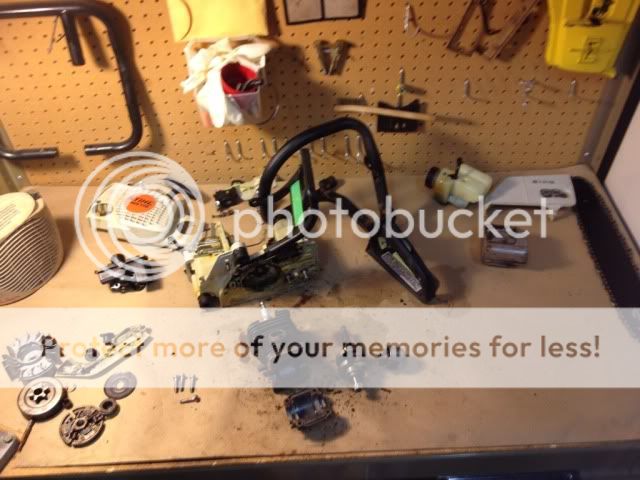STIHL officially recommends a mix ratio of 50:1 high quality (89 US octane minimum) unleaded gasoline to premix engine oil. 89 octane is typically what is called 'mid grade gas' in the US. Octane ratings vary worldwide as to what the octane numbers mean and how they are determined. In the US, octane is rated as the average of the research tested (at the refinery when it is fresh) and the gas station tank tested (after it has been delivered by pipe, truck or rail or some combination thereof). Meaning that the octane rating here is the average between the best octane level that the gas will ever have and what it will typically be when pumped into your tank. So when gas is pumped into your tank it already is likely to have a lower octane rating than what is posted on the pump. Once it is in your tank, if left untreated, it will typically continue to fall.
The rate at which the octane falls is influenced by the time of year that the gas is bought, and the container it is kept in. The volatility of gas in the US varies as to the time of year that it is refined. In the US we have what is called winter gas and summer gas. Winter gas is more volatle (lower vaporization pressure) and tends to have more lighter components (mainly butane) that waft off easier. Summer blends are heavier and tend to be more expensive, because butane and propane are cheap but they have to add less LP gas in summer. Which is one reason that gas is more expensive in summer than in the winter. There are 20 or 30 different seasonal blends so the actual vapor pressure requirements vary by region, and all states have their own requirements for gasoline blending on top of that, making it rather complicated. In many regions they require (or used to require) the adding of an oxegenate to gas in winter to lower smog during air inversion times. In places like California, they used MTBE to do that, but that is now banned. So they use ethenol now as an oxygenate for reducing smog year round as well as to appease the corn/ethanol/green lobby.
I try to buy and store winter gas becasue it is lighter and better as well as cheaper. Bigger bang for the buck. It will bubble up plastic gas cans more in the heat. Plastic gas cans breathe more than metal ones do, and some recommend that you store gas in metal cans for that reason. I use both types myself. I have a staged system for premium gas for my 2-stroke powered tools. I buy premium gas in a 5 gallon plastic jug and add Sta-Bil as soon as I get it home. Highest priority; get that stabilizer in there. Now it will be good for a year. Then I pour it into two one gallon plastic jugs as needed and I add premix oil to at that time. Adding premix will lower the octane rating as well, but adding any heavier oil to gas will do that. I use Elf 100% synthetic oil that I get from a motorcycle shop. It has a blue color added so that you know if the gas has been mixed with oil. If my gas is clear, it is regular for the lawn mower or unblended super for the 2-strokes. I keep my regular gas in metal cans so that it does NOT get into my 2-stroke engines. All 2-stroke engines are only one tank full away from being scored by straight gas

! I know way too many people that have straight gassed their saws to death. I have bought several of them and refitted them with new P&Cs;.
BTW; there is much debate as to what type and how much premix oil to use. I would recommend any 100% synthetic JASO FC or FD 2-stroke oil rated for air cooled engines. Do not use MARINE 2-stroke oil

! Noooooo! That is TCW rated, and is designed to run in water cooled engines. It will work in a pinch, but it will gunk up an air cooled engine over time. Read: AVOID! Also avoid any non-rated premix oil or 'all purpose' generic premix oil. They are likely to gunk up your engine, muffler screens, and foul your plugs. The same thing will happen with JASO FB rated oil over time, as I have experienced using Castrol FB premix oil. I flipped to Mobile 1 100% synthetic years ago and I noticed the difference instantly. The saws ran better, revved higher, the muffler screens stayed clear, and the engines looked better when I tore them down. I have some friends that are gold certified Stihl mechanics and they all note that even using a dyno or dyno-syn mix oil FC rated leaves more residue in the engine than 100% synthetic. Mobile 1 is not sold here any more, so I flipped to using Elf.
Lastly there is the topic of how much oil to add to the gas. You cannot really go wrong with 50:1 as recommended. There is an old argument from us older 2-stroke enduro motocross riders that more oil makes for a better ring seal and better lubrication of the low end and hence more power. But there is a tradeoff in lower octane and less power buring more oil as opposed to gas, as well as more fouling. So I tend to use about 45:1 for slightly better ring seal, and to err on using a tad more oil than a tad less. Some run 100:1 gas

il, but I would not recommend that.



 !
! il, but I would not recommend that.
il, but I would not recommend that.